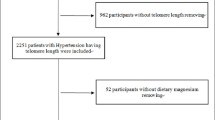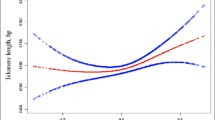Abstract
Cadmium is a toxic metal found ubiquitously throughout the world. Our study evaluated whether cadmium exposure was associated with telomere length in 73 female university students. Determination of telomere length was performed by quantitative polymerase chain reaction using DNA in blood. Urinary cadmium concentration was measured by inductively coupled plasma mass spectrometry. The students’ physiological attributes and lifestyle were surveyed by means of a self-administered questionnaire. The geometric mean of urinary cadmium concentration was 0.312 μg/g creatinine, which was lower than the levels previously reported for Japan. Urinary cadmium concentration was not significantly associated with telomere length, though the exposure level of the present subjects was similar to that of previous study subjects which found significantly negative associations. It is possible that other factors affected telomere length in this study population.
Similar content being viewed by others
Abbreviations
- BMI:
-
Body mass index
- ICP-MS:
-
Inductively coupled plasma mass spectrometry
- PCR:
-
Polymerase chain reaction
- T/S ratio:
-
Telomere/single copy gene ratio
References
ATSDR (Agency for Toxic Substances and Disease Registry) (2012) Toxicological profile for cadmium. Available: 〈http://www.atsdr.cdc.gov/toxprofiles/tp.asp?id=48&tid=15〉 (accessed 28.03.2018)
IPCS (International Programmeon Chemical Safety) (1992). Cadmium Environmental health criteria. Available: 〈http://wwwinchemorg/documents/ehc/ehc/ehc134htm〉 (accessed 28.03.2018)
FSCJ (Food Safety Commission of Japan) (2008) Pollutants assessment report for cadmium
Zota AR, Needham BL, Blackburn EH, Lin J, Park SK, Rehkopf DH, Epel ES (2015) Associations of cadmium and lead exposure with leukocyte telomere length: findings from National Health and Nutrition Examination Survey, 1999-2002. Am J Epidemiol 181:127–136. https://doi.org/10.1093/aje/kwu293
Lin S, Huo X, Zhang Q, Fan X, Du L, Xu X, Qiu S, Zhang Y, Wang Y, Gu J (2013) Short placental telomere was associated with cadmium pollution in an electronic waste recycling town in China. PLoS One 8:e60815. https://doi.org/10.1371/journal.pone.0060815
Fillman T, Shimizu-Furusawa H, Ng CFS, Parajuli RP, Watanabe C (2016) Association of cadmium and arsenic exposure with salivary telomere length in adolescents in Terai, Nepal. Environ Res 149:8–14. https://doi.org/10.1016/j.envres.2016.04.037
Kurenova EV, Mason JM (1997) Telomere functions. A Review Biochem 62:1242–1253
Blackburn EH (2005) Telomeres and telomerase: their mechanisms of action and the effects of altering their functions. FEBS Lett 579:859–862. https://doi.org/10.1016/j.febslet.2004.11.036
Aubert G, Lansdorp PM (2008) Telomeres and aging. Physiol Rev 88:557–579. https://doi.org/10.1152/physrev.00026.2007
Zhou Y, Ning Z, Lee Y, Hambly BD, McLachlan CS (2016) Shortened leukocyte telomere length in type 2 diabetes mellitus: genetic polymorphisms in mitochondrial uncoupling proteins and telomeric pathways. Clin Transl Med 5:8. https://doi.org/10.1186/s40169-016-0089-2
Wang J, Dong X, Cao L, Sun Y, Qiu Y, Zhang Y, Cao R, Covasa M, Zhong L (2016) Association between telomere length and diabetes mellitus: a meta-analysis. J Int Med Res 44:1156–1173. https://doi.org/10.1177/0300060516667132
Ma H, Zhou Z, Wei S, Liu Z, Pooley KA, Dunning AM, Svenson U, Roos G, Hosgood HD, Shen M, Wei Q (2011) Shortened telomere length is associated with increased risk of cancer: a meta-analysis. PLoS One 6:e20466. https://doi.org/10.1371/journal.pone.0020466
Zhu X, Han W, Xue W, Zou Y, Xie C, Du J, Jin G (2016) The association between telomere length and cancer risk in population studies. Sci Rep 6:1–10. https://doi.org/10.1038/srep22243
Kume K, Kikukawa M, Hanyu H, Takata Y, Umahara T, Sakurai H, Kanetaka H, Ohyashiki K, Ohyashiki JH, Iwamoto T (2012) Telomere length shortening in patients with dementia with Lewy bodies. Eur J Neurol 19:905–910. https://doi.org/10.1111/j.1468-1331.2011.03655.x
Honig LS, Kang MS, Schupf N, Lee JH, Mayeux R (2012) Association of shorter leukocyte telomere repeat length with dementia and mortality. Arch Neurol 69:1332–1339
O’Donnell CJ, Demissie S, Kimura M, Levy D, Gardner JP, White C, D’Agostino RB, Wolf PA, Polak J, Cupples LA, Aviv A (2008) Leukocyte telomere length and carotid artery intimai medial thickness: the Framingham heart study. Arterioscler Thromb Vasc Biol 28:1165–1171. https://doi.org/10.1161/ATVBAHA.107.154849
D’Mello MJJ, Ross SA, Briel M, Anand SS, Gerstein H, Paré G (2015) Association between shortened leukocyte telomere length and cardiometabolic outcomes: systematic review and meta-analysis. Circ Cardiovasc Genet 8:82–90. https://doi.org/10.1161/CIRCGENETICS.113.000485
Epel ES, Prather AA (2018) Stress, telomeres, and psychopathology: toward a deeper understanding of a triad of early aging. Annu Rev Clin Psychol 14:371–397. https://doi.org/10.1146/annurev-clinpsy-032816-045054
Zhu Y, Liu X, Ding X, Wang F, Geng X (2018) Telomere and its role in the aging pathways: telomere shortening, cell senescence and mitochondria dysfunction. Biogerontology 20(1):1–16. https://doi.org/10.1007/s10522-018-9769-1
von Zglinicki T (2002) Oxidative stress shortens telomeres. Trends Biochem Sci 27:339–344. https://doi.org/10.1016/S0968-0004(02)02110-2
Valko M, Rhodes CJ, Moncol J, Izakovic M, Mazur M (2006) Free radicals, metals and antioxidants in oxidative stress-induced cancer. Chem Biol Interact 160:1–40. https://doi.org/10.1016/J.CBI.2005.12.009
Huang J, Okuka M, Lu W, Tsibris JCM, McLean MP, Keefe DL, Liu L (2013) Telomere shortening and DNA damage of embryonic stem cells induced by cigarette smoke. Reprod Toxicol 35:89–95. https://doi.org/10.1016/J.REPROTOX.2012.07.003
Ikeda M, Zhang ZW, Moon CS, Shimbo S, Watanabe T, Nakatsuka H, Matsuda-Inoguchi N, Higashikawa K (2000) Possible effects of environmental cadmium exposure on kidney function in the Japanese general population. Int Arch Occup Environ Health 73:15–25. https://doi.org/10.1007/PL00007933
Ezaki T, Tsukahara T, Moriguchi J, Furuki K, Fukui Y, Ukai H, Okamoto S, Sakurai H, Honda S, Ikeda M (2003) No clear-cut evidence for cadmium-induced renal tubular dysfunction among over 10,000 women in the Japanese general population: a nationwide large-scale survey. Int Arch Occup Environ Health 76:186–196. https://doi.org/10.1007/s00420-002-0389-2
Rivai IF, Koyama H, Suzuki S (1990) Cadmium content in rice and its daily intake in various countries. Bull Environ Contam Toxicol 44:910–916. https://doi.org/10.1007/BF01702183
Tsukahara T, Ezaki T, Moriguchi J, Furuki K, Shimbo S, Matsuda-Inoguchi N, Ikeda M (2003) Rice as the most influential source of cadmium intake among general Japanese population. Sci Total Environ 305:41–51. https://doi.org/10.1016/S0048-9697(02)00475-8
MizunoY FE, Yoshinaga J (2017) Determination of urinary cadmium by ICP-MS: correction and removal of spectral interference from MoO. Biomed Res Trace Elem 28(4):154–161
Bonsnes RW, Taussky HH (1945) On colorimetric determination of creatinine by the Jaffe reaction. J Biol Chem 158:581–591
Cawthon RM (2002) Telomere measurement by quantitative PCR. Nucleic Acids Res 30:e47. https://doi.org/10.1093/nar/30.10.e47
Lin J, Epel E, Cheon J, Kroenke C, Sinclair E, Bigos M, Wolkowitz O, Mellon S, Blackburn E (2010) Analyses and comparisons of telomerase activity and telomere length in human T and B cells: insights for epidemiology of telomere maintenance. J Immunol Methods 352:71–80. https://doi.org/10.1016/j.jim.2009.09.012
Tucker LA (2017) Caffeine consumption and telomere length in men and women of the National Health and Nutrition Examination Survey (NHANES). Nutr Metab (Lond) 14:10. https://doi.org/10.1186/s12986-017-0162-x
Wang H, Kim H, Baik I (2017) Associations of alcohol consumption and alcohol flush reaction with leukocyte telomere length in Korean adults. Nutr Res Pract 11:334–339. https://doi.org/10.4162/nrp.2017.11.4.334
Wulaningsih W, Serrano FEC, Utarini A, Matsuguchi T, Watkins J (2016) Smoking, second-hand smoke exposure and smoking cessation in relation to leukocyte telomere length and mortality. Oncotarget 7:60419–60431. https://doi.org/10.18632/oncotarget.11051
Hunt SC, Chen W, Gardner JP, Kimura M, Srinivasan SR, Eckfeldt JH, Berenson GS, Aviv A (2008) Leukocyte telomeres are longer in African Americans than in whites: the National Heart, Lung, and Blood Institute family heart study and the Bogalusa heart study. Aging Cell 7:451–458. https://doi.org/10.1111/j.1474-9726.2008.00397.x
Tsuda M, Hasunuma R, Kawanishi Y, Okazaki I (1995) Urinary concentrations of heavy metals in healthy Japanese under 20 years of age: a comparison between concentrations expressed in terms of creatinine and of selenium. Tokai J Exp Clin Med 20:53–64
Ministry of Agriculture, Forestry and fisheries, 1981-2015. Annual change of Cd intake Available: 〈http://www.maff.go.jp/j/syouan/nouan/kome/k_cd/jitai_sesyu/attach/pdf/01_inv-6.pdf〉 (accessed 28.03.2018)
Ministry of Agriculture, Forestry and fisheries, 2003-2016. The tables of supply and demand of food Available: 〈http://www.maff.go.jp/j/zyukyu/fbs/〉 (accessed 28.03.2018)
Ministry of Agriculture, Forestry and fisheries, 2016. The results of survey of cadmium in food Available: 〈http://www.maff.go.jp/j/syouan/nouan/kome/k_cd/jitai_sesyu/01_inv.html〉 (accessed 28.03.2018)
Houben JMJ, Moonen HJJ, van Schooten FJ, Hageman GJ (2008) Telomere length assessment: biomarker of chronic oxidative stress? Free Radic Biol Med 44:235–246. https://doi.org/10.1016/j.freeradbiomed.2007.10.001
Waisberg M, Joseph P, Hale B, Beyersmann D (2003) Molecular and cellular mechanisms of cadmium carcinogenesis. Toxicology 192:95–117. https://doi.org/10.1016/S0300-483X(03)00305-6
Patra RC, Rautray AK, Swarup D (2011) Oxidative stress in lead and cadmium toxicity and its amelioration. Vet Med Int 2011:1–9. https://doi.org/10.4061/2011/457327
Jeng HA, Pan CH, Diawara N, Chang-Chien GP, Lin WY, Huang CT, Ho CK, Wu MT (2011) Polycyclic aromatic hydrocarbon-induced oxidative stress and lipid peroxidation in relation to immunological alteration. Occup Environ Med 68:653–658. https://doi.org/10.1136/oem.2010.055020
Flora SJS (2011) Arsenic-induced oxidative stress and its reversibility. Free Radic Biol Med 51:257–281. https://doi.org/10.1016/j.freeradbiomed.2011.04.008
Ling X, Zhang G, Chen Q, Yang H, Sun L, Zhou N, Wang Z, Zou P, Wang X, Cui Z, Liu J, Ao L, Cao J (2016) Shorter sperm telomere length in association with exposure to polycyclic aromatic hydrocarbons: results from the MARHCS cohort study in Chongqing, China and in vivo animal experiments. Environ Int 95:79–85. https://doi.org/10.1016/j.envint.2016.08.001
Pawlas N, Płachetka A, Kozłowska A, Broberg K, Kasperczyk S (2015) Telomere length in children environmentally exposed to low-to-moderate levels of lead. Toxicol Appl Pharmacol 287:111–118. https://doi.org/10.1016/j.taap.2015.05.005
Mannan T, Ahmed S, Akhtar E, Ahsan K, Haq A, Kippler M, Vahter M, Raqib R (2018) Associations of arsenic exposure with telomere length and naïve T cells in childhood– a birth cohort study. Toxicol Sci 164:539–549. https://doi.org/10.1093/toxsci/kfy105
Benetos A, Kark JD, Susser E, Kimura M, Sinnreich R, Chen W, Steenstrup T, Christensen K, Herbig U, Von Bornemann Hjelmborg J, Srinivasan SR, Berenson GS, Labat C, Aviv A (2013) Tracking and fixed ranking of leukocyte telomere length across the adult life course. Aging Cell 12:615–621
Vacchi-Suzzi C, Kruse D, Harrington J, Levine K, Meliker JR (2016) Is urinary cadmium a biomarker of long-term exposure in humans? A review. Curr Environ Health Rep 3(4):450–458
Acknowledgements
We thank the subjects of this study for their cooperation, and Ms. Yoko Nakamura, Faculty of Life Sciences, Toyo University, for helping with the preparation of the collection of samples.
Funding
This work was funded by a Grant-in-Aid for Scientific Research from the Japan Society for the Promotion of Science (grant number 16H05254).
Author information
Authors and Affiliations
Corresponding author
Ethics declarations
Conflict of Interest
Shoko Konishi and Jun Yoshinaga have received research grants from the Japan Society for the Promotion of Science.
Yuki Mizuno, Eiji Fujimori, Nobuhiko Kojima and Hideki Imai declare that they have no conflict of interest.
Ethical Approval
This study was approved by the Ethics Committee of Toyo University, Tokyo Healthcare University, and the Faculty of Medicine at the University of Tokyo in Japan.
Informed Consent
Informed consent was obtained from all individual participants included in the study.
Additional information
Publisher’s Note
Springer Nature remains neutral with regard to jurisdictional claims in published maps and institutional affiliations.
Electronic supplementary material
Table S1
(DOCX 15 kb)
Rights and permissions
About this article
Cite this article
Mizuno, Y., Konishi, S., Imai, H. et al. Cadmium Exposure and Blood Telomere Length in Female University Students in Japan. Biol Trace Elem Res 192, 98–105 (2019). https://doi.org/10.1007/s12011-019-1656-3
Received:
Accepted:
Published:
Issue Date:
DOI: https://doi.org/10.1007/s12011-019-1656-3




